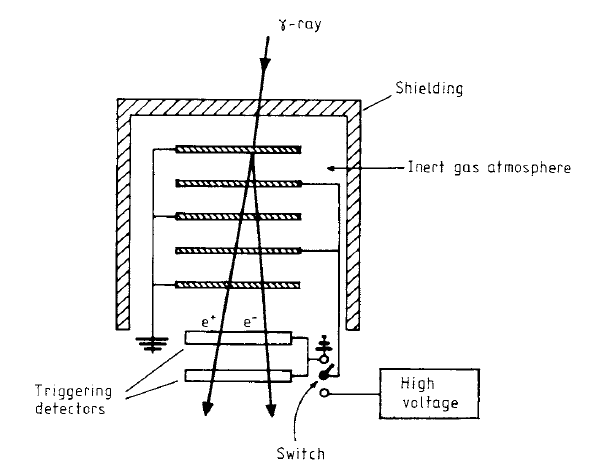


 الفيزياء الكلاسيكية
الفيزياء الكلاسيكية
 الكهربائية والمغناطيسية
الكهربائية والمغناطيسية
 علم البصريات
علم البصريات
 الفيزياء الحديثة
الفيزياء الحديثة
 النظرية النسبية
النظرية النسبية
 الفيزياء النووية
الفيزياء النووية
 فيزياء الحالة الصلبة
فيزياء الحالة الصلبة
 الليزر
الليزر
 علم الفلك
علم الفلك
 المجموعة الشمسية
المجموعة الشمسية
 الطاقة البديلة
الطاقة البديلة
 الفيزياء والعلوم الأخرى
الفيزياء والعلوم الأخرى
 مواضيع عامة في الفيزياء
مواضيع عامة في الفيزياء|
Read More
Date: 3-3-2016
Date: 14-8-2020
Date: 24-8-2020
|
γ -ray astronomy: Detectors and satellites
The γ -ray spectrum lies beyond the short wavelengths of hard x-rays and it is convenient to set the boundary of the two regions at photon energies of 1 MeV. Sources generating low-energy γ -rays require satellite platforms for their observation but at the extreme high-energy end of the spectrum, their arrival from cosmic sources can be recorded by the Earth’s atmosphere contributing to the detection system. The wavelengths of γ -rays are less than 0·1 A˚ , telling us immediately that very energetic processes are involved in their generation with some of them being nuclear and certainly not being associated with electronic transitions in the shells of atoms. Table 1 gives a broad classification of γ -ray energies and their methods and detection.
The scintillation counter already described under x-ray astronomy is used to detect low-energy γ -rays. The medium-to-high energy γ -ray photons can be detected by a spark chamber whose operation is similar to that of a cloud chamber. Figure 1 outlines the principal components. For a γ -ray to be detected, its impact on the first plate in the chamber produces an electron/positron pair (e−e+). Alternate plates in the chamber are charged to a high voltage and the strong electric fields cause breakdown of the gas along the paths of the charged particles. The trails of sparks can be recorded (TV or CCD cameras) with the results being telemetered to the Earth.
Table 1. γ -ray energies.


Figure1. The basic components of a spark chamber.
Several early satellites have carried γ -ray detectors, notably Explorer II, OSO III, SAS II and COS B. The detection system on board SAS II, which was operational for six months in 1972/73 was centred on the 100 MeV region. Some 8000 photons were recorded during its operation. The COS B satellite was launched in August 1975 and the system was operational for about six and a half years before the gas supply ran out. A cross section of the COS B γ -ray detector is depicted in figure 2.
Overall, some 200 000 γ -ray photons were detected with an angular precision of a few degrees. It is of interest to note that in many optical measurements the same number of photons might be recorded in one second! COS B detected about 25 sources, some of which have been identified optically. A giant step forward occurred in April 1991 with the launch of the Compton γ -ray observatory. Unlike earlier missions, Compton covered a broader band of energies from 30 keV to 3×104 MeV with 10 times higher sensitivity and greatly improved angular resolutions and timing capabilities. One of the on-board packages, BATSE, designed to investigate the γ -ray burster detected a new source virtually
every day, the 2000th event being recorded by the end of 1997, revealing a random distribution over the sky.
One of the aims of such telescopes is to be able to obtain a fix of any burster with sufficient accuracy to allow immediate follow-up of observations in other wavebands. In 1997, the BeppoSAX telescope detected a γ -ray burst that was identified optically within hours with a spectrum obtained by the KECK telescope suggesting that the event involved the most energetic phenomena at the limiting edges of the Universe.

Figure2. A sectional view of the COS B γ -ray detector equipment with a spark chamber (SC), a ˇCerenkov detector (C) and other photomultipliers (P) attached to scintillation systems. The enclosing dome (A) provides an anti-coincidence detection system.



|
|
|
|
تفوقت في الاختبار على الجميع.. فاكهة "خارقة" في عالم التغذية
|
|
|
|
|
|
|
أمين عام أوبك: النفط الخام والغاز الطبيعي "هبة من الله"
|
|
|
|
|
|
|
المجمع العلمي ينظّم ندوة حوارية حول مفهوم العولمة الرقمية في بابل
|
|
|